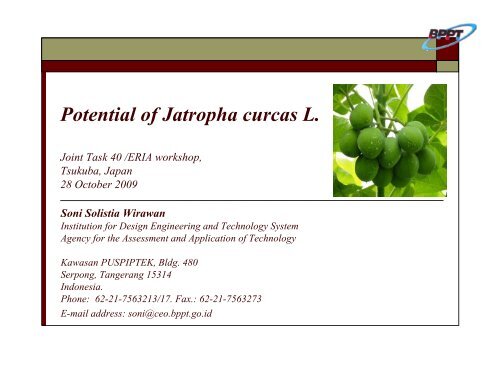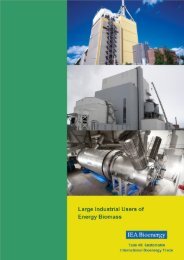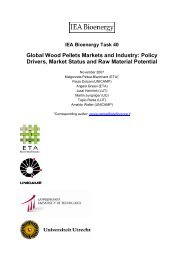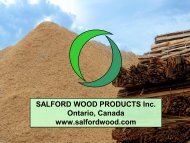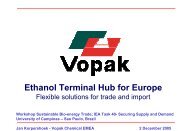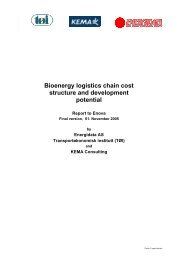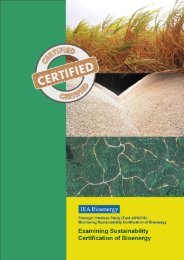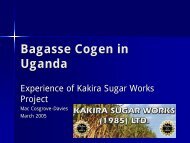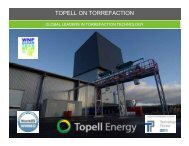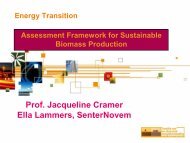Potential of Jatropha curcas L. - IEA Bioenergy Task 40
Potential of Jatropha curcas L. - IEA Bioenergy Task 40
Potential of Jatropha curcas L. - IEA Bioenergy Task 40
You also want an ePaper? Increase the reach of your titles
YUMPU automatically turns print PDFs into web optimized ePapers that Google loves.
<strong>Potential</strong> <strong>of</strong> <strong>Jatropha</strong> <strong>curcas</strong> L.Joint <strong>Task</strong> <strong>40</strong> /ERIA workshop,Tsukuba, Japan28 October 2009Soni Solistia WirawanInstitution for Design Engineering and Technology SystemAgency for the Assessment and Application <strong>of</strong> TechnologyKawasan PUSPIPTEK, Bldg. 480Serpong, Tangerang 15314Indonesia.Phone: 62-21-7563213/17. Fax.: 62-21-7563273E-mail address: soni@ceo.bppt.go.id
Outline1. Introduction <strong>of</strong> <strong>Jatropha</strong> Curcas L.2. <strong>Jatropha</strong> Curcas L. as a bi<strong>of</strong>uel3. <strong>Potential</strong> <strong>of</strong> <strong>Jatropha</strong> Curcas L.4. <strong>Potential</strong> <strong>of</strong> <strong>Jatropha</strong> Curcas L. In Indonesia5. <strong>Jatropha</strong> Curcas L. Development
1. Introduction <strong>of</strong><strong>Jatropha</strong> Curcas L
<strong>Jatropha</strong> <strong>curcas</strong> L.is a drought resistant species which is widelycultivated in the tropics as living fence. <strong>Jatropha</strong>Curcas widely adapted to various soil and climaticcondition.Climate Requirement Rainfall: 200 - 2000 mm/yr (Heller, 1996) 480 - 2380 mm/yr (Jones and Miller, 1992) > 250, optimal 900 – 1200 mm/yr (Becker & Makkar, 1999) > 600 mm/th: normal growth (Henning, 2004)Rainfall to high: less fertilization Long summer: fall <strong>of</strong> leaves, less growth Very dry area: plant growth only 2 – 3mhigh On dry climate needwatering/irrigation Altitude: 0-1700 m in above sea level Temperature: 11-38 deg. C
Value Added Product• Making soap (from jatropha oil) to supply local need/demand.• utilizing jatropha press cake to generate biogas that could be use locally ashousehold cooking fuel; the farmers are thus freed from expenses to buykerosene or fuelwood. The use biogas is also more comfortable than that <strong>of</strong>kerosene and fuelwood.• If the farmer cooperative itself owns the oil expelling unit/factory, the presscake can be utilized to generate biogas (for use as local fuel) and the residue(that contain soil mineral matters) can be recycled to maintain the ‘fertility’ <strong>of</strong>the land.• If the jatropha press cake could be detoxified, then this proteinaceous cakewould be an excellent feed for cattle. This (cattle breeding) is another potentialeconomic chain that may be exploited from <strong>Jatropha</strong> <strong>curcas</strong> seed. The cattledung would then serve as feedstock for biogas generators/digesters.• Researches on detoxification <strong>of</strong> <strong>Jatropha</strong> <strong>curcas</strong> press cake are urgentlyneeded to further increase the economic viability <strong>of</strong> <strong>Jatropha</strong> <strong>curcas</strong>cultivation.
2. <strong>Jatropha</strong> Curcas L.as a Bi<strong>of</strong>uel
<strong>Jatropha</strong> Oil (JO) ProductionCRUDEJATROPHA OILSCLARIFICATIONPRESSED OILDEGUMMINGJATROPHA OIL(JO)Fatty acids content <strong>of</strong> <strong>Jatropha</strong>Curcas oil________________________________________________Fatty acids (%m/m) (1) (2)___________________________________________Palmitic acids 14-15 14.2Stearic acids 7 6.9Oleic acids 34-45 43.2Linoleic acids 31-43 34.3Others fatty acids 1.2 1.4________________________________________________(1) Foidl et al., 1996(2) Analysis result at Pilot laboratory in ChemicalEngineering Department <strong>of</strong> Institut Teknologi Bandung.The seeds are supplied from Sumbawa Island, Indonesia1. PPO/SVO2. Feedstock <strong>of</strong> BiodieselProduction
Physicochemical properties <strong>of</strong> <strong>Jatropha</strong> Curcas oil.PropertyDensity at 15 o CKinematic viscosity at 30 o CFlash PointCetane NumberSulphur (S) contentCarbon residuFluid pointWater contentAcid valueIodine valueSaponification valueUnsaponifiable matterPhosphor (P) contentCalcium (Ca) contentMagnesium (Mg) contentFe contentUnitg/cm 3mm 2 /soC-ppm%m/moCppmmg KOH/g-mg KOH/g%m/mppmppmppmppmValue(1) (2)0.93052.0210-2<strong>40</strong><strong>40</strong>-45-0.64--0.9-190-1981290561032.<strong>40</strong>.917749.15236-< 10.34-2.59354.7596.5------(1) Foidl et al.(1996), Kumar et al. (2001), Pramanik (2003)(2) (2) Analysis result at Pilot laboratory in Chemical Engineering Department<strong>of</strong> Institut Teknologi Bandung. The seeds are supplied from SumbawaIsland, Indonesia.
Properties <strong>of</strong> Biodiesel fuel from <strong>Jatropha</strong> Curcas oilProperties Unit Methyl Ester (1) Ethyl Ester (2)Density at 15 o CKinematic viscosity at 30 o CFlash PointCetane NumberCarbon residuPhosphor (P) contentCalcium (Ca) contentMagnesium (Mg) contentFe content(1)Foidl et al.,(1996), Gubitz et al., (1999)(2)Foidl et al., (1996)g/cm 3mm 2 /soC-%m/mppmppmppmppm0.8794.84191510.0217.56.11.<strong>40</strong>.90.8865.5419059-17.54.<strong>40</strong>.80.3
3. <strong>Potential</strong> <strong>of</strong><strong>Jatropha</strong> Curcas L.
Distribution <strong>Jatropha</strong> around the world (<strong>Jatropha</strong> Belt)
Projected area <strong>of</strong> <strong>Jatropha</strong> <strong>curcas</strong> L. cultivation in eachregion in 2017Note:1. The figure <strong>of</strong> the worldwide <strong>Jatropha</strong>Curcas L cultivation plan announced byThe International <strong>Jatropha</strong> Organization2. Will be 32.72 million ha, producing 160million tons <strong>of</strong> seed in 20173. 31.25 million ha <strong>of</strong> land in Asia4. The development potential is especiallyhigh in India, China and IndonesiaSource:Chew Chong Siang, IEEJ, 2009
Projected production <strong>of</strong> <strong>Jatropha</strong> <strong>curcas</strong> L. in AsianCountries in 2017Note:1. Assumming 5 tons <strong>of</strong>seeds/hectare2. China 19.05 millions tons3. India 16.5 million tons4. Indonesia 6.75 millions tons5. Myanmar 4.25 millions tonsSource:Chew Chong Siang, IEEJ, 2009
National Energy MIXTargeted Energy MIX 2025 #Energy MIX 2003Gas26.5%Coal14.1%Hydro3.4%Geothermal1.4%Coal33%Gas30%Oil20%Bi<strong>of</strong>uel5% Geothermal5%Others7%NuclearBiomassHydroSolarWindLiq. CoalOthers0.2%Oil54.4%Bi<strong>of</strong>uel will have atleast 5% share <strong>of</strong>total National EnergyMIX 2025#Presidential Decree No. 5/2006
BIOFUEL FOR FUEL SUBSTITUTION (2010)FUELTRANSPORTATION(31,7 Million kL)ELECTRICITY(7,6 Million kL)KEROSENE(10 Million kL)PREMIUM(18,529Million kL)1,85 Million kLBIOETANOLADO(12,4 Million kL)1,24 Million kLBIODIESEL3,8 Million kL 1 Million kLBIO OIL4,8 Million kLRAWMATERIALCASSAVA11 Million tonsMOLASSES600 Million tonsPALM OIL30,2 Million tonsJATROPHA OIL3,84 MIllion tons
<strong>Potential</strong> <strong>of</strong> <strong>Jatropha</strong> Curcas L.Cultivation area distribution in IndonesiaNote: S1 (Most appropriate), S2 (Appropriate), S3 (less/marginal appropriate)Source: Allorerung et al., 2006
<strong>Potential</strong> <strong>of</strong> <strong>Jatropha</strong> Curcas Lcultivation area distribution in IndonesiaPROVINCE S1 S2 S3 TOTALNanggroe Aceh Darussalam 180,139 160,764 836,001 1,176,904Sumatera Utara 215,393 - 1,390,475 1,605,868Sumatera Barat 4,269 - 781,189 785,458Riau 80,718 - 1,600,844 1,681,562Jambi 218,284 - 993,134 1,211,418Sumatera Selatan 530,207 - 3,229,784 3,759,991Bengkulu - - 602,022 602,022Lampung 718,823 66,023 706,931 1,491,777Kepulauan Bangka Belitung 156,319 - 947,881 1,104,200Jawa Barat 231,011 445,022 306,989 983,022Jawa Tengah 494,630 74,416 338,824 907,870Daerah Istimewa Yogyakarta 35,227 33,999 8,454 77,680Jawa Timur 960,595 574,121 255,722 1,790,438Banten 134,484 116,576 36,646 287,706Bali 19,892 51,423 24,265 95,580Note: S1 (Most appropriate), S2 (Appropriate), S3 (less/marginal appropriate)Source: Allorerung et al., 2006
<strong>Potential</strong> <strong>of</strong> <strong>Jatropha</strong> Curcas L.Cultivation area distribution in IndonesiaPROVINCE S1 S2 S3 TOTALNusa Tenggara Barat 37,877 428,539 124,466 590,882Nusa Tenggara Timur 595,421 833,293 322,174 1,750,888Kalimantan Barat 67,463 984,3<strong>40</strong> 3,897,005 4,948,808Kalimantan Tengah 171,063 - 3,632,324 3,803,387Kalimantan Selatan 833,745 48,559 623,326 1,505,630Kalimantan Timur 3,643,059 680,468 2,878,161 7,201,688Sulawesi Utara 143,760 - 538,555 682,315Sulawesi Tengah 506,887 - 373,638 880,525Sulawesi Selatan 435,483 122,<strong>40</strong>7 613,780 1,171,670Sulawesi Tenggara 1,015,825 27,248 177,833 1,220,906Gorontalo 290,146 13,701 - 303,847Maluku 766,888 162,982 316,223 1,246,093Maluku Utara 809,470 - 716,909 1,526,379Papua 980,457 711,030 3,445,699 5,137,186TOTAL 14,277,535 5,534,911 29,719,254 49,531,700Note: S1 (Most appropriate), S2 (Appropriate), S3 (less/marginal appropriate)Source: Allorerung et al., 2006
5. <strong>Jatropha</strong> Curcas L.Development
Why <strong>Jatropha</strong>?- Non edible oil (toxic), not conflicting with food- Able to grow in arid zones- Inter cropping to increase land productivity- Optimize use <strong>of</strong> marginal land, decentralized solutions for remote area per hectareyields (ton)- <strong>Potential</strong> for bi<strong>of</strong>uel production<strong>Jatropha</strong> Curcas L. gained a worldwide reputation asa plant that can be grown in wasteland and infertileland, does not require much water, fertilizer,management and has high oil content.When development <strong>of</strong> <strong>Jatropha</strong> Curcas L. Startedlater on a commercial basis, these exaggeratedcharacterizations were cause <strong>of</strong> numerousmisunderstandingR & D still needed !!!
ProblemsThe cultivation <strong>of</strong> <strong>Jatropha</strong> <strong>curcas</strong> inIndonesia is short <strong>of</strong> high quality clones.There is huge variation in seed yield capacityand oil concentration in the seeds among theseedling used for cultivation or plantation.<strong>Jatropha</strong> tree with the fruits number <strong>of</strong> 10-1515in one brunch is considered as the aboveaverage quality mother plant (highproductivity).However that kind <strong>of</strong> trees are rare.
ProblemsFruits <strong>of</strong> <strong>Jatropha</strong> in one brunch ripe atdifferent time. It causes difficulty duringharvesting, that farmer has to selectripening fruits only. This makesharvesting time slow and high cost.Uniformity <strong>of</strong> maturity will reduceharvesting cost. Some diseases and insects affect thegrowth <strong>of</strong> <strong>Jatropha</strong> Disease and insect resistance clones isneeded to maintain high productivitySpots on leafInsect in <strong>Jatropha</strong>Curly leaves
Problems <strong>Jatropha</strong> oil has moderate-highviscosity, reducing its viscosity mayextend its utilization to all dieselengines. <strong>Jatropha</strong> Oil (JO) was tested intocar engine. Converter has to be addedinto machine to warm up and reduceJO viscosity The oil contains toxic substances. Does italso lead to toxic emissions ?.
Development:On Farm TechnologyDNA Marking and breedingClones with superior CharactersVigor and high seed yieldHigh seed oil content and seed compositionFruit uniformity <strong>of</strong> maturationDisease and insect resistanceEnvironmental stress resistanceHarvesting methodEtc.Processing Technology and Product TestingHigh quality <strong>of</strong> <strong>Jatropha</strong> oil/biodieselBy product procesingInvestigation <strong>of</strong> jatropha biodiesel emissionEtc.
<strong>Jatropha</strong> Curcas R&D:Indonesian Center for Estate CropsResearch and Development (ICERD)Source: Prastowo B., ICERD, 2008
ReferencesAllorerung, D., Mahmud, Z., Arivin, A. R., Effendi, D. S., Anny M. 2006. Teknologi dan BenihUnggul Harapan Indonesia, Lokakarya Status Teknologi Budidaya Jarak Pagar (<strong>Jatropha</strong><strong>curcas</strong> L.): Jakarta, 11 – 12 April 2006.Becker, K., and H.P.S. Makkar. 1999. <strong>Jatropha</strong> and Moringa. Source <strong>of</strong> renewable energy for fuel,edible oil, animal feed and pharmaceutical products- ideal trees for increasing cash income.Presented at Daimler Chrysler/The World Bank Environment Forum, Magdeburg.Heller, Joachim. 1996. Physic Nut (<strong>Jatropha</strong> <strong>curcas</strong> L.). Promoting the conservation and use <strong>of</strong>underutilised and neglected crops. 1. Institute <strong>of</strong> Plant Genetics and Crop Plant Research.Gatersleben/International Plant Genetic Resources Institute, Rome.Henning, R. K. 2004. The <strong>Jatropha</strong> System. Economy and Dissemination Strategy. InternationalConference <strong>of</strong> Renewable 2004. Bonn 1-4 June 2004, Germany.Prastowo, B. 2008. New Development in <strong>Jatropha</strong> Curcas R&D in Pakuwon. Indonesian Center forEstate Crops Research and Development (ICERD), Pakuwon. Sukabumi.Siang, C.C. 2009. <strong>Jatropha</strong> Curcas L. Development <strong>of</strong> a New Oil Crop for Bi<strong>of</strong>uel. The Institute <strong>of</strong>Energy Economics, Japan.Soerawidjaja, T.H. 2007. Increasing Economic Viability <strong>of</strong> <strong>Jatropha</strong> Curcas Cultication ThroughIntegrated Processing, <strong>Jatropha</strong> Curcas Conference, IPB, Bogor, June 19, 2007.Tajuddin,T. And Bolu, W.O.H. 2009. Improvement <strong>of</strong> <strong>Jatropha</strong> Curcas L. Through Marker-Assisted Breeding for High Seed Yield and Oil Content. Biotechnology Center – BPPT.Wirawan, S.S. 2007. BIODIESEL PRODUCTION (Case <strong>of</strong> Jathropa Curcas L Feedstock).Konferensi Nasional 2007 Jarak Pagar “Menuju Bisnis Jarak Pagar Yang Feasible”. GedungMMA IPB Bogor, 19 Juni 2007.


